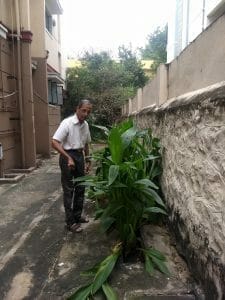Sewerage management has become a Herculean problem in Chennai. Thanks to the inaction by government departments, our sewage reaches our water bodies sans any treatment, either through the storm water drain network or private septic tanks. The hard reality is that the pumping stations are running beyond their capacities, resulting in sewage stagnation in many localities including Adambakkam and Egmore.
But how many of us know that grey water recycling can not only address these issues to a large extent but can also cut down on the household monthly water budget? By making use of the water used in the kitchen, bathroom sinks and washing machines that contain organics and salts, we can significantly reduce the continuing pollution of our lakes and rivers.
Though the idea is a new one for many, a few apartment complexes have proved how grey water recycling can stabilise our ground water tables and also help address sewage management woes.
An apartment’s success story
A residential apartment in Saidapet, which has been recycling grey water for 16 years now serves as an example for all Chennaiites, who are all too familiar with the problems of sewage mismanagement and water crisis. The apartment, housing eight households in Sri Nagar Colony of Saidapet, has adopted recycling by preparing the necessary infrastructure at the construction stage itself.

Indukanth S Ragade, a grey water recycling expert initiated the procedure at an apartment in Saidapet. Pic: Laasya Shekhar
Through separate pipelines, grey water is diverted to a bed of water-loving plants. Indukanth S Ragade, a grey water recycling expert and author of a book titled ‘Self reliance in water – A practical manual for town and city dwellers’ introduced the idea to the apartment dwellers around twelve years ago.
“It is simple and requires minimal additional budget, when provided for at the construction stage itself. Grey water in our apartments reaches the Canna Indica plants, the roots of which absorb the organics present in the soap and detergent. All these plants require is sunlight and regular pruning.”
The water then seeps into the layers of the soil and recharges the closed well which was built a few steps away from the plants. Explaining the procedure, Ragade says: “The plants can absorb water up to 5 cm deep within 45 minutes. There is no chance of stench.” The closed well is connected to three chambers of an overhead tank and can be used for non-potable purposes including gardening and flushing.
So what happens to the organics? Our bath soaps contain long chains of fatty acids that are biodegradable. Linear alkyl benzene sulphonate and Sodium tripolyphosphate are the components present in the detergents that are easily soluble. On average, a person uses one gram of toilet soap with 90,000 gms of water, which makes the compounds in grey water negligible.
Indukanth points out that the roots of the indigenous plants including Canna indica, Heliconium and plantain act as filters in removing these organics, while retaining the salts.Water then seeps into the layers of soil, where it goes through natural cleansing,” said Indukanth. However, the percentage of salts would remain the same. “500 parts of inorganic salts is ideal,” he mentioned.
Residents of the apartment admit that the procedure has been fruitful, and they have been able to reduce reliance on private water tankers. We have not accounted for the amount of water saved. But our ground water goes dry only during the peak summer season (around May), unlike in other apartments who have to start buying water from February itself,” said V H Prasad, a 92-year-old resident, who spearheaded the project in the apartment.
Reducing pressure on existing STPs
Grey water (from sinks, bathtubs, washing machines etc) accounts for around 65 per cent of the household usage, while black water (sewage from toilets) amounts to 35 per cent. By recycling grey water, the quantity of water released to the underground sewage network can be reduced.
“It is stupid to mix the resourceful grey water with the sewage, when you can recycle it in your own household. A lot of the government’s expenditure in running and treating sewage in the Sewage Treatment Plants (STPs) can be brought down, if grey water is not sent to the septage-carrying pipes in our streets,” said Indukanth. In his opinion, the lateral movement (one-way outflow) of grey water which dominates the urban scenario should be replaced with cyclical movement (reuse/recycling).
A dead law
Grey water is one of the issues dealt with in the very crowded rainwater harvesting ordinance, 2003. The 2003 ordinance that made the implementation of RWH systems compulsory in all existing buildings in Tamil Nadu also mandates that “Wastewater from the bath and wash basin shall be treated by organic or mechanical recycling and taken to a sump for onward pumping to an exclusive overhead tank for use in toilet flushing. Any excess shall be connected to the rainwater harvesting structures for groundwater recharge.”
This, however, largely remains rhetoric in Chennai. The reasons cited by experts are the lack of awareness among civilians as well as government officials. A Metrowater official simply avoided the topic, stating that recycled water is unhealthy.
A feasible solution now appears to be in the hands of the Chennai Metropolitan Development Authority and Chennai Corporation, if they make grey water recycling mandatory for all residential projects.